How to Grow and Care for Palm Trees Indoors
- January 24, 2024
- 0 comment
Discover essential tips for nurturing indoor palm trees, ensuring vibrant growth and a tropical ambiance at home. Indoor palm trees offer a practical way to infuse your home with a touch of the tropics. These elegant plants not only improve room aesthetics but also contribute to air purification, promoting a healthier environment.
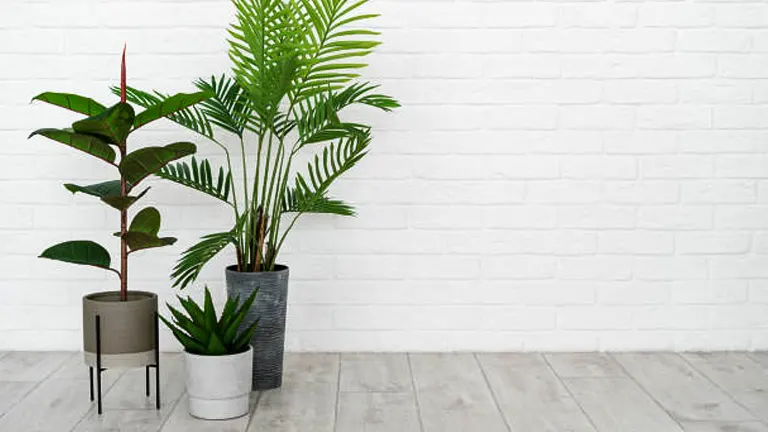
Successful growth of these palms hinges on meeting their specific care requirements, including adequate light, water, and the right soil mix. This guide will explore the fundamental aspects of nurturing palm trees indoors, aimed at helping these graceful plants thrive in your living space.
Table of Contents
- What Is a Palm?
- Selecting the Right Indoor Palm
- Planting Your Indoor Palm
- Caring for Your Palm Plant
- Benefits of Having Palms Indoors
- Factors to Consider Before Buying Palm Trees
- Common Challenges and Solutions
- Conclusion
- FAQs
What Is a Palm?
Indoor palm trees, hailing from the diverse Arecaceae family, offer more than just aesthetic appeal. They serve as a lush, living connection to the tropics. With an impressive range of over 2,600 species across 181 genera, indoor palms present a variety of forms – from the grandeur of towering species to the charm of smaller houseplants. Their signature evergreen fronds, elegantly poised on unbranched stems, add a distinct and refreshing touch to indoor environments.
| Specification | Details |
|---|---|
| Common Name | Palm tree |
| Botanical Name | Arecaceae family |
| Family | Arecaceae |
| Plant Type | Woody perennial trees and shrubs |
| Mature Size | Miniature to towering giants |
| Sun Exposure | Partial shade to full sun |
| Soil Type | Moist but well-drained, sandy loam preferred |
| Soil pH | Neutral to acidic |
| Bloom Time | Year-round (rarely flower indoors) |
| Flower Color | Often yellow, orange, green, pink |
| Hardiness Zones | 7-11 (USDA), varies by species |
| Native Area | South America, the Caribbean, Asia, and more |
| Growth Rate | Slow to moderate, depending on species |
| Watering Needs | Regular but moderate, avoid overwatering |
| Fertilization | Balanced, slow-release fertilizers; less frequent in winter |
| Propagation | Generally by seed |
| Common Pests | Spider mites, mealybugs, scale insects |
| Special Features | Air purifying, varied leaf structures, can adapt to indoor environments |
| Pruning | Minimal; remove only dead or dying fronds |
| Toxicity | Generally non-toxic |
Selecting the Right Indoor Palm
When choosing an indoor palm, it’s important to understand the specific needs of different species. Here are five exceptional choices for indoor cultivation:
1. Bamboo Palm (Chamaedorea seifrizii)
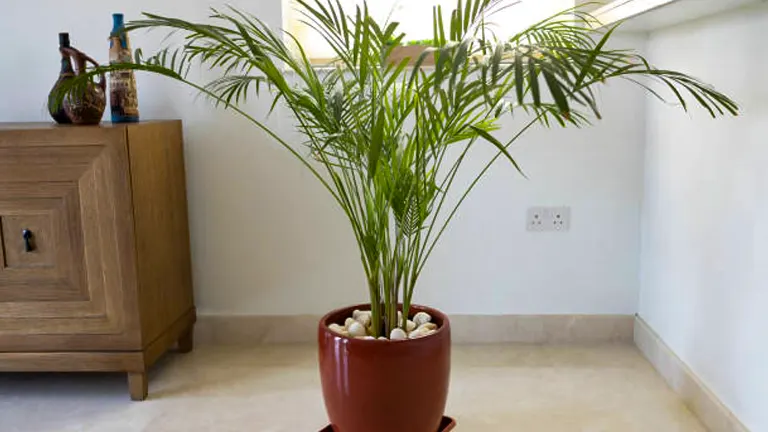
The Bamboo Palm, with its ability to adapt to lower light conditions, is a fantastic choice for bringing vibrant greenery into less sunny spaces. It’s not just about the aesthetics; this palm is also known for its air-purifying qualities, making it a healthy addition to any indoor setting.
- Air Purification: Excellent at filtering formaldehyde and benzene.
- Growth Habit: Can grow up to 5-7 feet tall.
- Watering Needs: Prefers consistent moisture but dislikes waterlogging.
- Ideal Placement: Best in areas away from direct sunlight, like living rooms with shaded windows.
2. Chinese Fan Palm (Livistona chinensis)
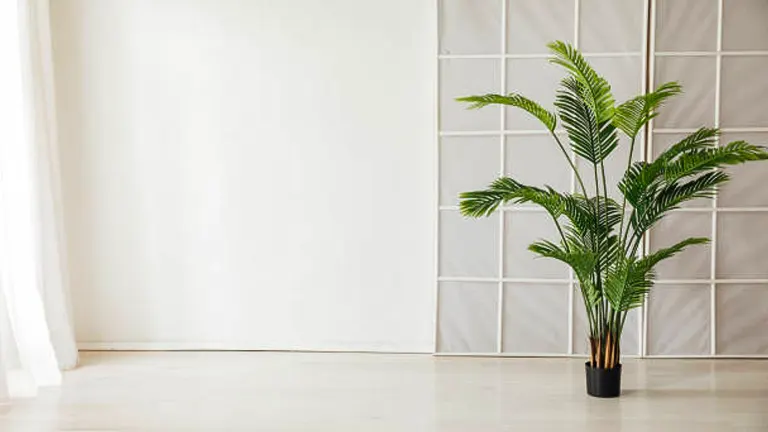
The Chinese Fan Palm is renowned for its large, fan-like fronds that can bring a dramatic flair to any room. Thriving in bright, indirect light, this palm is perfect for spaces that receive plenty of natural but diffused sunlight.
- Sunlight Adaptation: Can handle some direct sun in non-peak hours.
- Indoor Height: Typically reaches 6-8 feet.
- Soil Preference: Loves well-draining soil.
- Design Tip: Makes a stunning focal point in large, airy rooms.
3. Date Palm (Phoenix dactylifera)
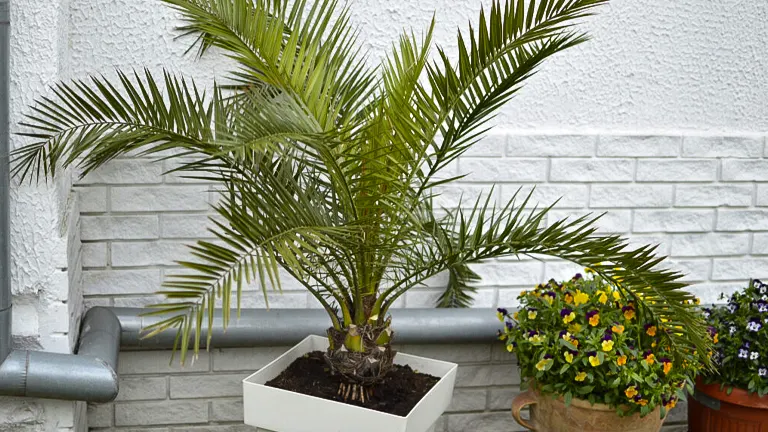
The Pygmy Date Palm, a variant of the Date Palm, is particularly suited for indoor cultivation. Its preference for indirect light and manageable size makes it a favored choice for adding a touch of sophistication to indoor spaces.
- Light Requirement: Prefers bright, indirect light.
- Indoor Growth: Usually grows up to 4-5 feet.
- Watering: Moderate watering, with well-drained soil.
- Aesthetic Appeal: Brings an elegant and sophisticated vibe to any room.
4. Majesty Palm (Ravenea rivularis)
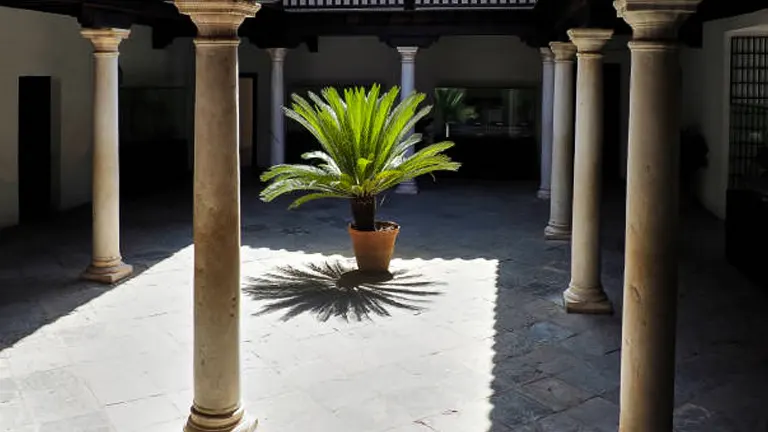
Loved for its love of humidity and its slow-growing nature, the Majesty Palm is an excellent air purifier and a beautiful addition to any indoor garden. Its fondness for bright light and high moisture makes it particularly well-suited for bathrooms or kitchens.
- Humidity Requirements: Thrives in high humidity.
- Air Purifying Abilities: Effective at removing indoor air toxins.
- Maximum Height Indoors: Can reach up to 10 feet.
- Room Recommendation: Ideal for bathrooms or kitchens where humidity is higher.
5. Parlor Palm (Chamaedorea elegans)
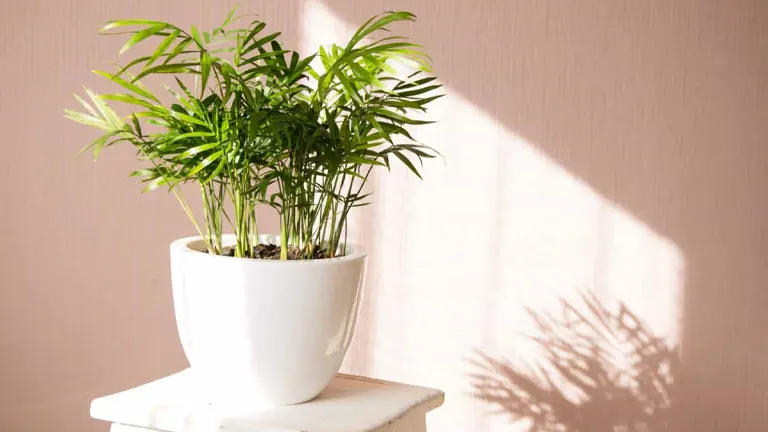
The Parlor Palm, with its adaptability to low-light conditions, is one of the easiest palms to care for. Its compact size and elegant appearance make it a timeless choice for bringing greenery into darker corners of your home.
- Low Light Adaptation: Perfect for areas with minimal natural light.
- Care Level: Low maintenance, ideal for beginners.
- Growth Size: Typically grows up to 3-4 feet in height.
- Historical Background: Popular since the Victorian era, adding a classic touch to modern interiors.
Planting Your Indoor Palm
1. Selecting the Right Palm Variety
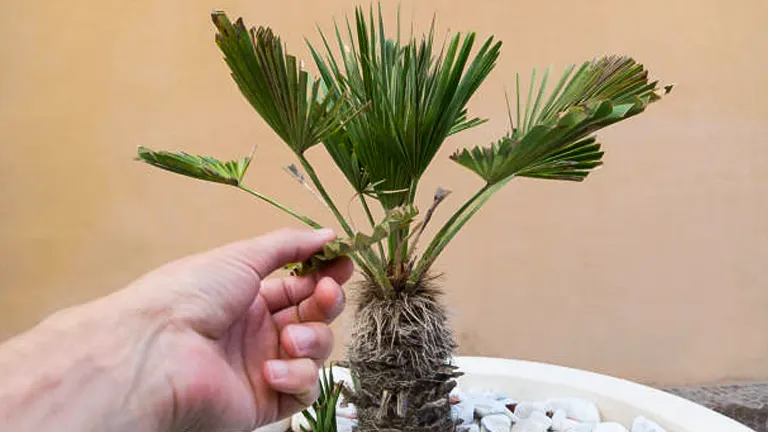
Choosing the right type of palm is crucial for successful indoor growth. Each variety has its unique characteristics and care requirements.
- Research Varieties: Understand the growth habits, size, and light requirements of different palms like Parlor, Majesty, or Areca Palms.
- Space Consideration: Consider the available space in your home. Some palms grow larger than others and may not be suitable for confined spaces.
2. Preparing the Growing Space
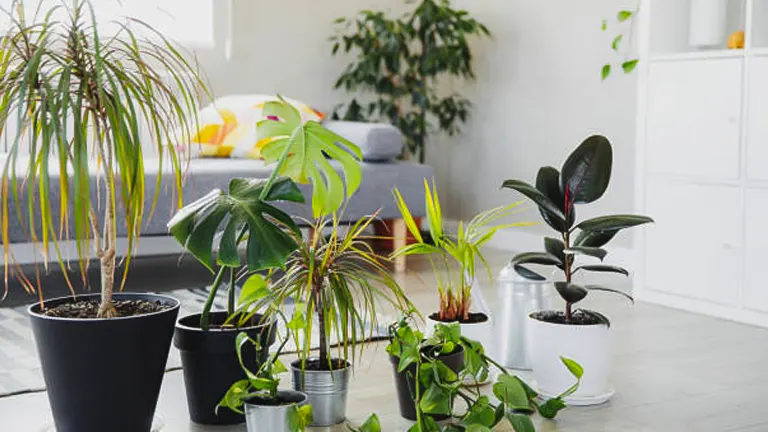
Creating an environment conducive to palm growth is vital for their development.
- Lighting: Palms generally prefer bright, indirect light. Identify a spot in your home that receives ample light but is shielded from direct sun.
- Temperature: Maintain a consistent indoor temperature, preferably between 65°F and 75°F.
- Humidity: Increase indoor humidity levels if necessary, as palms thrive in more humid environments. Humidifiers or pebble trays with water can help.
3. Germinating Palm Seeds
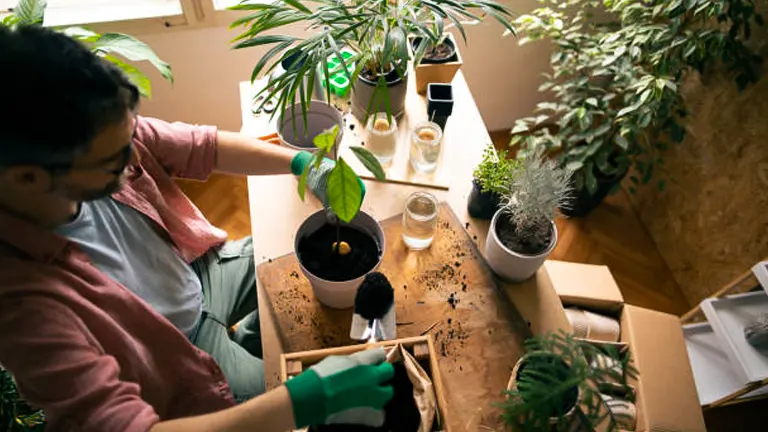
Growing palms from seeds is a rewarding process that requires patience and attention to detail. The germination process is crucial and varies based on the palm species.
- Creating the Right Environment: Ensure a consistently warm and humid environment. A temperature range of 70-100°F is typically ideal.
- Soil Preparation: Use a light, well-draining soil mix. Mixing in sand or vermiculite can improve drainage and aeration.
- Seed Placement: Plant the seeds shallowly, just beneath the soil surface.
- Moisture Control: Keep the soil consistently moist but not waterlogged. Using a spray bottle for watering can prevent over-saturation.
- Timeframe: Germination can take anywhere from two to six months, depending on the species. Patience is key.
4. Transplanting Seedlings
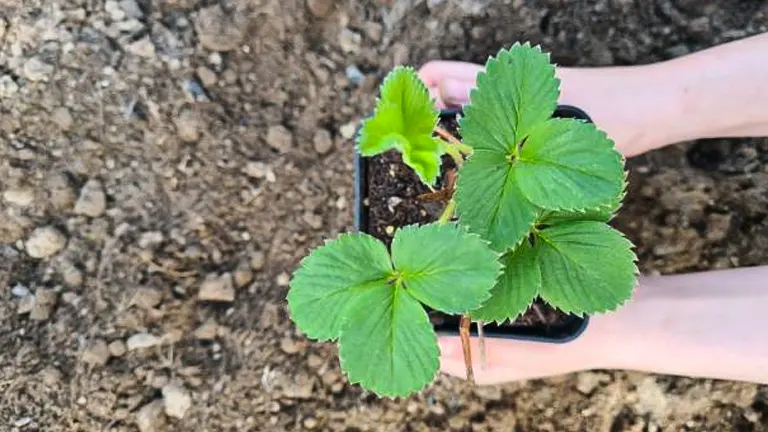
After the seeds have sprouted, the next step is to transplant the seedlings into larger pots where they can continue to grow.
- Choosing the Right Pot: Select a pot that is slightly larger than the seedling’s root ball and has good drainage holes.
- Soil for Transplanting: Use a potting mix suitable for palms. It should be rich in organic matter and well-draining.
- Handling Seedlings: Gently remove the seedling from its initial container, being careful not to damage the roots.
- Planting Depth: Place the seedling at the same depth it was growing at previously.
- Watering After Transplanting: Water the plant thoroughly after transplanting to settle the soil around the roots.
- Post-Transplant Care: Keep the seedling in a warm, bright location but away from direct sunlight until it establishes.
5. Ongoing Care Post-Transplant
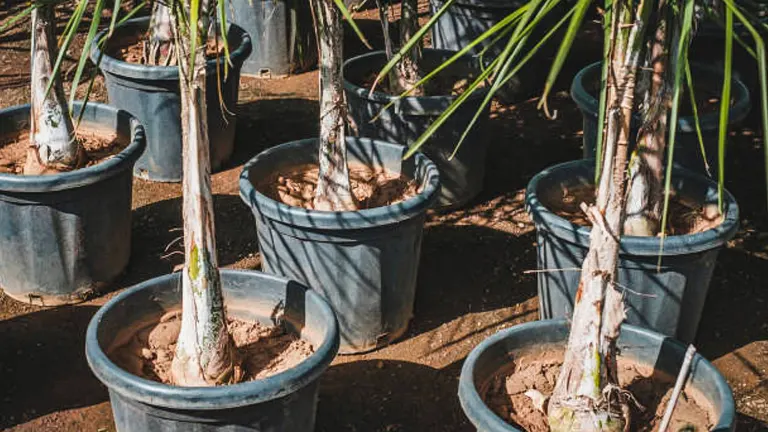
Regular care and observation are key to the healthy growth of indoor palms.
- Watering Schedule: Establish a consistent watering routine. Palms prefer soil that is moist but not soggy.
- Fertilization: Start fertilizing with a diluted palm-specific fertilizer about 4-6 weeks after transplanting.
- Regular Inspection: Regularly inspect your palm for signs of pests or disease and take action promptly if any are detected.
- Monitoring Growth: Regularly check for signs of growth or stress. Adjust care as needed, especially in the first few months after transplanting.
Caring for Your Palm Plant
1. Light and Temperature Requirements
Indoor palms are best suited to environments where they can receive bright, but indirect sunlight. This preference mimics their natural understory habitat in tropical regions. Ensure that the temperature remains consistently above 50°F, as palms can suffer in colder conditions. To protect your palms from leaf scorching, avoid placing them in direct sunlight, especially during the intense midday hours. Utilizing sheer curtains can help diffuse strong sunlight, providing a more suitable light quality.
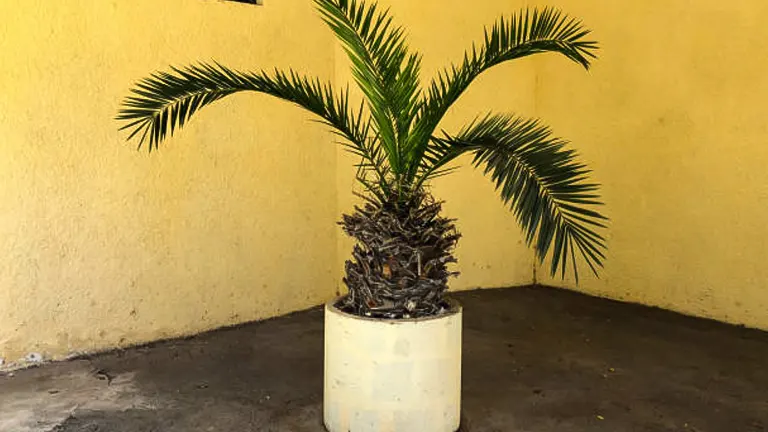
Additional Tips: Place your palms in areas where they can receive filtered sunlight, such as near east- or west-facing windows. Using sheer curtains can help diffuse direct sunlight, providing optimal light conditions without the risk of leaf scorching. Keep an eye on the room’s temperature, particularly in colder months, using a thermostat or indoor thermometer to ensure a palm-friendly climate.
2. Soil and Watering
Choosing the right soil and maintaining a balanced watering schedule are key to the health of palm plants. A loose, porous soil mixture, often a combination of peat, pine bark, and perlite, ensures good drainage and prevents waterlogging. When watering, allow the top inch of the soil to dry out before adding more water. This approach prevents overwatering, which is a common issue leading to root rot, often indicated by yellowing leaves. It’s essential to use a pot with drainage holes to avoid excess moisture accumulation.
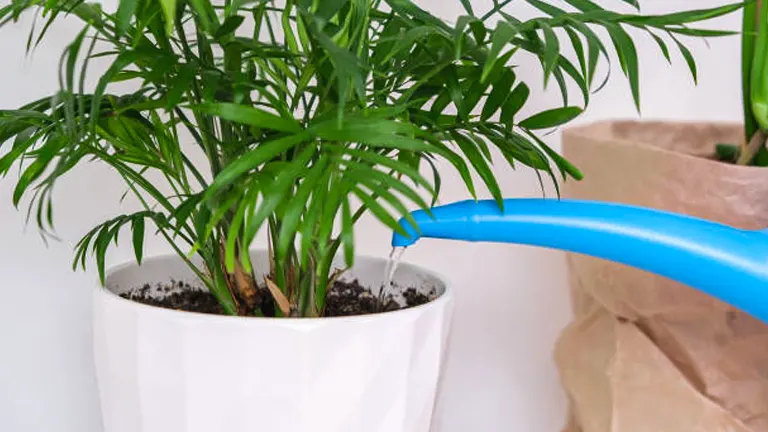
Additional Tips: Water your palm when the top inch of the soil feels dry, usually once a week, depending on the humidity and temperature of your home. It’s crucial to use pots with drainage holes to prevent excess water accumulation. If the leaves begin to yellow, this could be a sign of overwatering, so adjust your schedule accordingly. Ensuring the right balance of moisture is vital for the health and growth of your palm.
3. Humidity and Fertilization
Palms naturally thrive in humid environments. To replicate these conditions indoors, especially in drier climates or during winter months, use a humidifier or mist the leaves regularly. Additionally, placing your palm plant on a pebble tray filled with water can increase the humidity around the plant. Fertilize your palms several times a year with a balanced, palm-specific or general houseplant fertilizer to ensure they receive the necessary nutrients. Be cautious not to over-fertilize, as this can lead to nutrient burn.

Additional Tips: Use a humidifier in the room or regularly mist your palm’s leaves to increase the humidity. Another effective method is to place the pot on a pebble tray filled with water, which increases humidity as the water evaporates. Fertilize your palms several times a year with a balanced, palm-specific or general houseplant fertilizer, but avoid over-fertilization to prevent nutrient burn.
4. Pruning and Maintenance
Proper pruning and maintenance are crucial for the aesthetic and health of your palm plant. Regularly remove dead or browning fronds to promote healthy growth. However, be cautious not to over-prune, as palms utilize their fronds for photosynthesis and nutrient absorption. Never cut the top off a palm plant, as this can stop its growth and potentially kill it. Inspect your palm regularly for signs of stress or disease, and address any issues promptly to maintain its health and vigor.

Additional Tips: Regularly inspect your palm and prune away any dead or browning fronds to encourage healthy growth. Use clean, sharp pruning tools to make precise cuts. However, be cautious not to over-prune, as the fronds are essential for photosynthesis and nutrient absorption. Avoid cutting the top of the palm, as this can halt its growth. Regular inspections for signs of stress or disease are also important, with prompt intervention to maintain the plant’s health.
5. Monitoring for Pests
Palms, while relatively hardy, are not immune to the common pests that afflict many indoor plants. Spider mites, mealybugs, and scale insects are particularly notorious for targeting indoor palms. These pests can cause a range of issues, from discolored fronds to stunted growth. The enclosed, stable environment of a home or greenhouse can sometimes exacerbate these problems, as it often lacks the natural predators found in an outdoor setting.
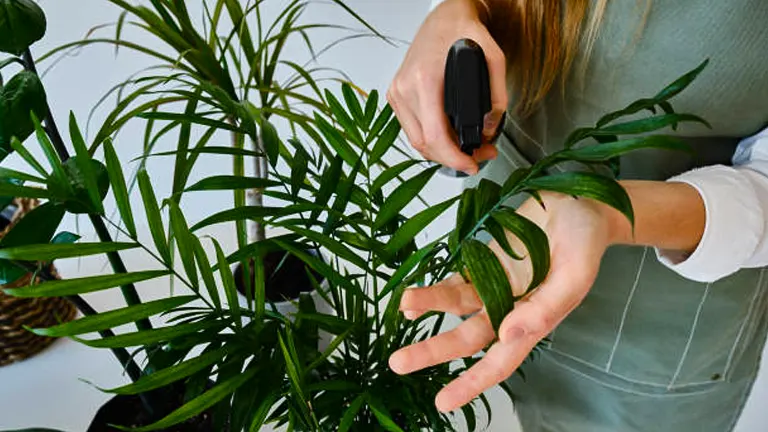
Additional Tips: To safeguard your palm, it’s essential to conduct regular inspections of both the upper and lower sides of the fronds, as well as the stem. If you spot any signs of pests, such as small webs (spider mites), white cottony masses (mealybugs), or brown bumps (scale insects), act quickly. Treat the infested palm with insecticidal soap or neem oil, following the product’s instructions carefully. In some cases, a more aggressive treatment may be necessary to eradicate the pests completely.
6. Repotting When Necessary
One of the unique aspects of palm care is their preference for being somewhat root-bound. Unlike many other plants that require frequent repotting to prevent root crowding, palms often thrive in confined root conditions. This preference is partly due to their natural growing conditions, where they must adapt to limited soil resources. Frequent repotting can disturb a palm’s roots, causing unnecessary stress and potentially harming the plant.
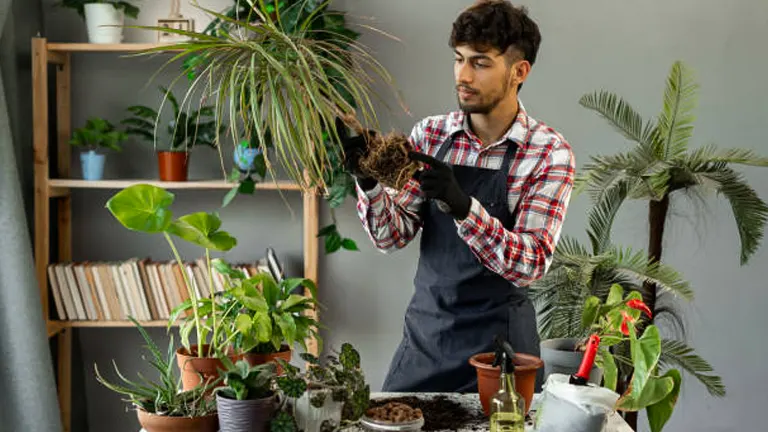
Additional Tips: Repotting should only be done when your palm has clearly outgrown its current container, typically every 2-3 years. When it’s time to repot, choose a new container that is only slightly larger than the existing one. Ensure the new pot has ample drainage holes to prevent water accumulation. When transferring the palm, be gentle with the roots to minimize stress. Use fresh potting soil that’s well-suited for palms, and water the plant thoroughly after repotting to help settle the soil around the roots.
Benefits of Having Palms Indoors
- Air Purification: Palms are known for their ability to purify indoor air. Many species, like the Areca Palm and the Lady Palm, are particularly effective at removing indoor pollutants such as formaldehyde, benzene, and carbon monoxide from the air. This natural filtration contributes to a healthier living environment, making palms not just decorative, but functional too.
- Enhancing Indoor Aesthetics: Palms add a touch of elegance and tropical beauty to any indoor space. With their lush green fronds and unique shapes, they can transform mundane spaces into more vibrant and inviting areas. This aesthetic improvement can also enhance mood and create a more relaxing atmosphere, ideal for homes and workplaces alike.
- Humidity Regulation: Palms can help in maintaining and regulating indoor humidity levels. By releasing water vapor during transpiration, palms increase indoor humidity, which can be particularly beneficial in drier climates or during winter months when indoor air tends to be dry due to heating systems.
- Psychological Benefits: The presence of indoor plants, including palms, has been linked to various psychological benefits. Studies suggest that having plants indoors can reduce stress, increase productivity, and improve overall well-being. The calming effect of greenery and the act of caring for plants can offer a therapeutic and rewarding experience.
- Noise Reduction: Palms can also contribute to a quieter indoor environment. The dense foliage of palm plants can absorb sound, making them a natural choice for reducing ambient noise levels. This can be particularly advantageous in offices or apartments where external noise can be a distraction.
Factors to Consider Before Buying Palm Trees
- Suitable Species for Your Climate: Not all palm species thrive in the same climate conditions. It’s important to choose a species that can flourish in your local weather. For example, if you live in a region with cold winters, look for cold-hardy palms like the Parlor Palm or Kentia Palm.
- Space Availability: Palms can vary significantly in size. Some, like the Majesty Palm, can grow quite tall, while others, such as the Pygmy Date Palm, remain relatively small. Consider the space where you intend to place the palm, both in terms of height and spread, to ensure it can grow without constraints.
- Light Requirements: Different palm species have varying light requirements. While some palms, like the Areca Palm, thrive in bright, indirect light, others can tolerate low-light conditions. Assess the light availability in your space and choose a palm variety that matches those conditions.
- Maintenance Level: The maintenance needs of palm trees can vary. Some palms require regular pruning, fertilization, and specific watering schedules, while others are more low-maintenance. Consider how much time and effort you’re willing to invest in caring for your palm.
- Indoor vs. Outdoor: Determine whether you want an indoor or outdoor palm. Indoor palms often have different care requirements and may be more suited to container growth, while outdoor palms might need more space and specific soil conditions.
- Growth Rate and Longevity: Some palm species grow quickly, while others take years to reach their full size. Consider how the growth rate fits with your landscaping or indoor decor plans. Also, think about the palm’s longevity and how it will fit into your long-term space planning.
- Pest and Disease Resistance: Like all plants, palms can be susceptible to certain pests and diseases. Research the common issues faced by the palm species you’re considering and ensure you’re prepared to manage them, especially if you’re choosing a more sensitive variety.
Common Challenges and Solutions
1. Insufficient Light: Palms, especially those grown indoors, can suffer from inadequate light, leading to stunted growth or yellowing leaves. While most indoor palms prefer bright, indirect light, they can struggle in dimly lit spaces.
Solution: Place your palm near a window that receives plenty of natural light but is shielded from direct sunlight. If natural light is limited, consider using grow lights to supplement the light needs of your palm.
2. Overwatering and Root Rot: Overwatering is a common issue with indoor palms, often leading to root rot, a condition where the roots decay due to excessive moisture.
Solution: Ensure your palm’s pot has good drainage and only water the plant when the top inch of soil is dry. If you suspect root rot, repot the palm into fresh soil and trim any black or mushy roots.
3. Pest Infestations: Indoor palms are susceptible to pests like spider mites, mealybugs, and scale insects. These pests can damage the plant, leading to discolored leaves and stunted growth.
Solution: Regularly inspect your palm for signs of pests. If pests are found, treat the plant with insecticidal soap, neem oil, or a suitable pesticide. Keeping the leaves clean and dust-free can also help prevent infestations.
4. Inadequate Humidity: Being tropical plants, palms thrive in high humidity environments, which can be challenging to maintain indoors, especially in dry climates or during winter.
Solution: Increase the humidity around your palm by misting it regularly, using a humidifier, or placing a water-filled pebble tray underneath the pot. Grouping plants together can also raise the humidity in their immediate vicinity.
5. Nutrient Deficiencies: Indoor palms may suffer from nutrient deficiencies, often indicated by yellowing leaves or slow growth, if not fertilized properly.
Solution: Use a balanced, water-soluble fertilizer formulated for indoor palms. Fertilize only during the growing season (spring and summer) and follow the recommended frequency and dosage to avoid over-fertilization.
Each of these challenges is common for indoor palm caretakers, but with the right strategies and attentive care, they can be effectively managed or prevented, ensuring the healthy growth of your indoor palms.
Conclusion
In conclusion, successfully growing and nurturing palm trees indoors requires understanding their specific needs for light, water, soil, and humidity. With proper care and attention, these elegant plants can thrive, enhancing your indoor spaces with their unique tropical beauty.
FAQs
- How Often Should I Water My Indoor Palm Tree?
Water your palm when the top inch of soil feels dry. Frequency depends on factors like humidity and temperature but generally ranges from once a week to every other week. - What Is the Best Soil Mix for Indoor Palm Trees?
A well-draining soil mix is key. Use a combination of peat, pine bark, and perlite. This mix ensures proper moisture retention and aeration. - How Much Light Does an Indoor Palm Need?
Most palms prefer bright, indirect light. Place them near a window with sheer curtains to filter intense sunlight. Avoid direct sun exposure to prevent leaf scorching. - Do Indoor Palms Require High Humidity?
Yes, palms generally thrive in humid conditions. Increase humidity by misting the leaves, using a humidifier, or placing the pot on a pebble tray with water. - When and How Should I Fertilize My Indoor Palm?
Fertilize during the growing season (spring and summer) with a balanced, water-soluble fertilizer. Follow the instructions and avoid over-fertilizing to prevent nutrient burn. - How Do I Prune an Indoor Palm Tree?
Prune to remove dead or dying fronds only. Use clean, sharp shears and avoid over-pruning, as palms need their fronds for photosynthesis. - What Are Common Pests That Affect Indoor Palms and How Do I Treat Them?
Watch out for spider mites, mealybugs, and scale insects. Treat infestations with insecticidal soap or neem oil, and keep the leaves clean to prevent pests. - Can I Propagate My Indoor Palm Tree From Cuttings?
Most palm trees do not propagate well from cuttings. They are typically propagated from seeds, but this can be a challenging and slow process.
In closing, the journey of nurturing indoor palm trees is both rewarding and enriching, blending natural beauty with the comforts of home. With the right care, attention to their specific needs, and a bit of patience, these magnificent plants will thrive indoors, adding a touch of the tropics to your living space. Happy gardening!

Benjamin Brooks
Forestry AuthorGreetings! I'm Benjamin Brooks, and my journey over the past 15 years has revolved around the fascinating realms of content creation, expertise in snow clearing, and the intricate world of lumberjacking and landscaping. What began as a simple curiosity about the natural world and heavy machinery has evolved into a passionate profession where my love for crafting words intertwines seamlessly with my lumberjacking and garden skills.













Leave your comment